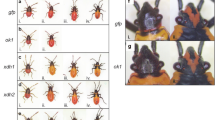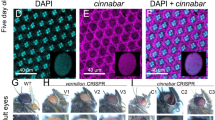Abstract
RECENTLY, Sturtevant1 has criticized work on white-eyed mutants of Culex2, Calliphora3 and Phormica (= Phormia)4, on the grounds that such mutations are not comparable with white-eyed types in Drosophila. Sturtevant claims that while there are two pigments, a red and a brown, in the wild-type eye of Drosophila, there is only one pigment, a brown, in Calliphora, and that this is the usual condition in insects. Thus, the wild-type eye of Calliphora would be like the brown mutant of Drosophila in which red pigment is absent; and, moreover, in that case it would not be possible to distinguish morphologically white, vermilion, cinnabar and scarlet mutants in Calliphora or in other Diptera in which red pigment is not present in the wild-type eye. In support of this view, Sturtevant quotes the work of Becker5 on the eye-pigments of Arthropods.
This is a preview of subscription content, access via your institution
Access options
Subscribe to this journal
Receive 51 print issues and online access
$199.00 per year
only $3.90 per issue
Buy this article
- Purchase on Springer Link
- Instant access to full article PDF
Prices may be subject to local taxes which are calculated during checkout
Similar content being viewed by others
References
Sturtevant, A. H., Nature, 160, 754 (1947).
Gilchrist, B. M., and Haldane, J. B. S., Hereditas, Lund, 33, 175 (1947).
Tate, P., J. Genet., 48, 176 (1947).
Dichler, H., Amer. Nat., 77, 287 (1943).
Becker, E., Z. indukt. Abstamm.-u. VererbLehre, 80, 157 (1942).
Tate, P., J. Genet., [48, 338 (1948)].
Tate, P., J. Genet., 48, 192 (1947).
Mohr, O. L., Z. indukt. Abstamm.-u. VererbLehre, 32, 108 (1923).
Schubel, F., Amer. Nat., 68, 279 (1934)
Author information
Authors and Affiliations
Rights and permissions
About this article
Cite this article
TATE, P. White-eyed Mutants of Diptera. Nature 161, 641–642 (1948). https://doi.org/10.1038/161641a0
Issue Date:
DOI: https://doi.org/10.1038/161641a0
This article is cited by
-
Der Sauerstoffverbrauch der Insektenretina im Licht und im Dunkeln
Zeitschrift f�r Vergleichende Physiologie (1962)
-
White-eyed Mutants in Calliphora erythrocephala, Meig
Nature (1949)
Comments
By submitting a comment you agree to abide by our Terms and Community Guidelines. If you find something abusive or that does not comply with our terms or guidelines please flag it as inappropriate.



